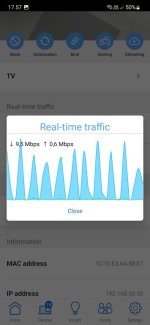I've just bought a pair of XT8s to go with my 1000/1000 MB internet connection.
The XT8 node has 'great' signal strength to the 'XT8 router' via wireless(5GHz) backhaul. I'll get 430/250 MB wireless wifi on my S22 phone from the node, which I'm pleased with.
However, watching the World cup final just now, the TV (wifi5/802.11ac) lagged even though the Node is placed just 30 cm (1 ft) from the TV.
Cheking the download connection to the TV, it looked like the tv had dropouts: only internet for 1 second, then 1 second of 0 Mbps, then 1 second with connection and so on. (see attached screenshots). Earlier the day I experienced the same 'dropouts' when streaming radio on smart loudspeakers. Is this normal?
What should I change to get stabel connection to my streaming devices?
Thanks!
The XT8 node has 'great' signal strength to the 'XT8 router' via wireless(5GHz) backhaul. I'll get 430/250 MB wireless wifi on my S22 phone from the node, which I'm pleased with.
However, watching the World cup final just now, the TV (wifi5/802.11ac) lagged even though the Node is placed just 30 cm (1 ft) from the TV.
Cheking the download connection to the TV, it looked like the tv had dropouts: only internet for 1 second, then 1 second of 0 Mbps, then 1 second with connection and so on. (see attached screenshots). Earlier the day I experienced the same 'dropouts' when streaming radio on smart loudspeakers. Is this normal?
What should I change to get stabel connection to my streaming devices?
Thanks!
Attachments
-
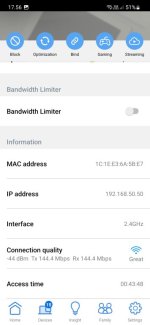 Screenshot_20221218_175634_ASUS Router.jpg32.9 KB · Views: 47
Screenshot_20221218_175634_ASUS Router.jpg32.9 KB · Views: 47 -
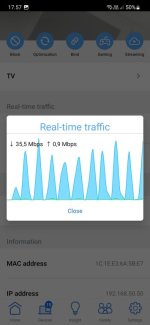 Screenshot_20221218_175734_ASUS Router.jpg31.9 KB · Views: 55
Screenshot_20221218_175734_ASUS Router.jpg31.9 KB · Views: 55 -
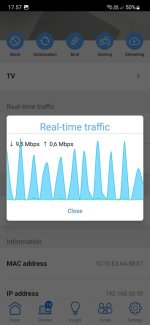 Screenshot_20221218_175743_ASUS Router.jpg32.2 KB · Views: 56
Screenshot_20221218_175743_ASUS Router.jpg32.2 KB · Views: 56 -
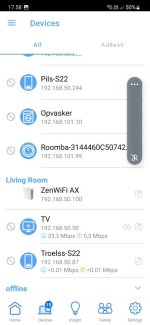 Screenshot_20221218_175810_ASUS Router.jpg37.8 KB · Views: 45
Screenshot_20221218_175810_ASUS Router.jpg37.8 KB · Views: 45 -
 Screenshot_20221218_175815_ASUS Router.jpg22.7 KB · Views: 46
Screenshot_20221218_175815_ASUS Router.jpg22.7 KB · Views: 46


